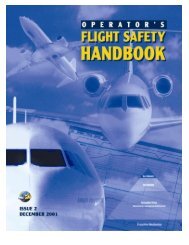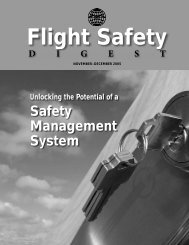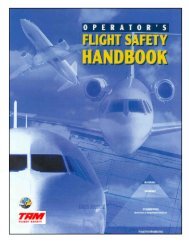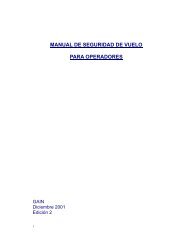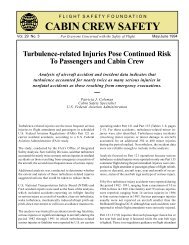Download PDF [10.9 MB] - Flight Safety Foundation
Download PDF [10.9 MB] - Flight Safety Foundation
Download PDF [10.9 MB] - Flight Safety Foundation
You also want an ePaper? Increase the reach of your titles
YUMPU automatically turns print PDFs into web optimized ePapers that Google loves.
values] went all over the place until<br />
[one was] below his company limit, and<br />
then he said, ‘Yeah, going to land.’ He<br />
went off [the runway].”<br />
As noted, applying the manufacturer’s<br />
crosswind-handling technique<br />
for the specific aircraft type/model/<br />
size is the best practice in risk management.<br />
But even this cannot be 100<br />
percent successful, given the unique<br />
and dynamic forces in play. “The poor<br />
pilot … is confronted with all kinds of<br />
confusion and issues when he has to<br />
decide whether or not to land in a gusty<br />
crosswind,” van Es said. “It should be<br />
company policy that you can ask for<br />
another runway or divert if you don’t<br />
feel comfortable — if the wind conditions<br />
are unfavorable — because that is<br />
a very good defense in these cases.”<br />
Since the release of the 2010 and<br />
2012 reports, with further EASA–NLR<br />
communication through industry<br />
forums and pending articles for airlines’<br />
Actual Events Involving Strong Gusty<br />
Crosswind Conditions vs. Guidance to Pilots<br />
Actual crosswind (kt)<br />
50<br />
45<br />
40<br />
35<br />
30<br />
25<br />
20<br />
15<br />
10<br />
5<br />
Excursion<br />
Hard landing<br />
Tail strike<br />
Wing/pod strike<br />
FLIGHTSAFETY.ORG | AEROSAFETYWORLD | MAY 2013<br />
safety magazines, a number of operators<br />
say they will revisit their policies<br />
and procedures, van Es told Aero<strong>Safety</strong><br />
World. Convincing civil aviation authorities,<br />
however, is likely to take more time.<br />
“The regulatory [part] is always difficult<br />
in terms of who is taking the lead in<br />
this case, especially because it’s a multiactor<br />
issue,” he said, and this involves the<br />
initiative of operators, manufacturers,<br />
regulators and the aviation meteorology<br />
community. “The regulators are hesitating<br />
to go left or right. They don’t know<br />
exactly what to do.”<br />
Basically, the problem they face is<br />
some degree of mismatch in certification<br />
of aircraft versus operational use<br />
of aircraft. “What EASA has said is<br />
that they are looking to publish … a<br />
sort of safety bulletin on this topic,”<br />
van Es said. “But changing regulations?<br />
I think that’s a step too far for them.<br />
There are big advantages in educating<br />
the pilots because they often have great<br />
0<br />
0 5 10 15 20 25 30 35 40 45 50<br />
Manufacturer advised/operator applied crosswind (kt)<br />
Notes: Occurrences studied by NLR included some that happened when crosswind components<br />
exceeded the values in guidance to flight crews, and others below those values.<br />
Source: G.W.H. van Es and Emmanuel Isambert, NLR<br />
Figure 1<br />
THREATANALYSIS<br />
difficulties in understanding … wind<br />
report [sources]. There is a lot of misconception<br />
within crews about how the<br />
systems work. … The best experience is<br />
the real experience, but for an average<br />
line pilot, to have a lot of these landings<br />
could be quite rare.”<br />
Notes<br />
1. EASA. Near-Ground Wind Gust Detection.<br />
Research Project EASA. 2011/08 NGW.<br />
Van Es, G.W.H. “Analysis of Existing<br />
Practices and Issues Regarding Near-<br />
Ground Wind Gust Information for<br />
<strong>Flight</strong> Crews”. NLR Report no. NLR-<br />
CR-2012-143, October 2012.<br />
2. Citing World Meteorological Organization<br />
(WMO) WMO-No. 731, the NLR report<br />
published by EASA says, “A gust can be<br />
defined as the difference between the<br />
extreme value and the average value of<br />
the wind speed in a given time interval.<br />
A gusty wind is characterized by rapid<br />
fluctuations in wind direction and speed.<br />
At airports, gustiness is specified by the<br />
extreme values of wind direction and<br />
speed between which the wind has varied<br />
during the last 10 minutes.”<br />
3. For example, EASA’s internationally harmonized<br />
regulation (Part 25.237, “Wind<br />
Velocities”) states, “For landplanes and<br />
amphibians, a 90-degree cross component<br />
of wind velocity, demonstrated to<br />
be safe for takeoff and landing, must be<br />
established for dry runways and must<br />
be at least 20 kt or 0.2 V SO , whichever is<br />
greater, except that it need not exceed 25<br />
kt. Note that V SO means the stall speed or<br />
the minimum steady flight speed in the<br />
landing configuration.”<br />
4. The report said, “Since 1990, there have<br />
been more than 280 approach and landing<br />
[accidents] and 66 takeoff accidents/<br />
incidents investigated with [Part]<br />
25–certified aircraft operated in commercial<br />
operations worldwide in which<br />
crosswind or tailwind was a causal factor.<br />
Occurrences related to gusty wind<br />
conditions are also very common in<br />
Europe. … The wind in these occurrences<br />
was often very gusty.”<br />
| 43


![Download PDF [10.9 MB] - Flight Safety Foundation](https://img.yumpu.com/18550968/45/500x640/download-pdf-109-mb-flight-safety-foundation.jpg)

![Download this Issue [PDF 7 MB] - Flight Safety Foundation](https://img.yumpu.com/18859635/1/190x245/download-this-issue-pdf-7-mb-flight-safety-foundation.jpg?quality=85)
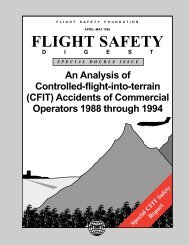
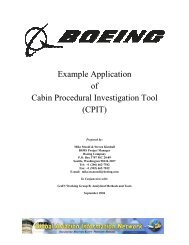
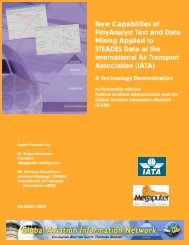
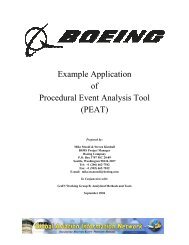
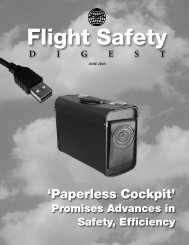
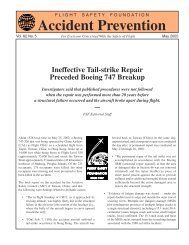
![Download [PDF 8 MB] - Flight Safety Foundation](https://img.yumpu.com/18859366/1/190x245/download-pdf-8-mb-flight-safety-foundation.jpg?quality=85)
